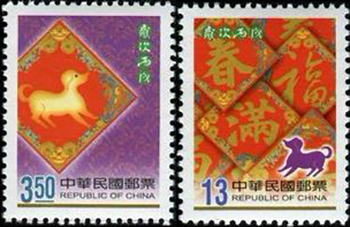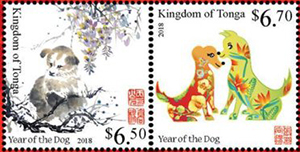Laika, space dog | lunar new year stamps | earlier collections
祝你新春快乐!祝你狗年好!
We wish you the best possible Year of the Dog! As is our custom, we’ve collected the lunar new year stamps issued by countries and regions. This year’s collection includes 48 issuers and 146 stamps. And because a dog, Laika, was part of the 20th century race to the moon, we’ve also brought you stamps issued to commemorate her 1957 journey on Sputnik 2.
With the rise of electronic communication, however, fewer stamps, including lunar new year stamps are bring printed. In the last year of the dog, 2006, the Canadian authorities printed eight million lunar new year stamps. This year, they printed just 62,000.
 |
 |
 |
| Top: E. Han sculpture, Los Angeles County Museum of Art; Middle: Castiligone, Taipei National Palace Museum; Bottom: He, China Art Museum |
Dogs have been a part of Chinese life for thousands of years. You can see this in funerary sculptures from the Han dynasty. Some of the best known pre-modern paintings of dogs, however, were those of the Jesuit missionary Giuseppe Castiligone (1688-1766), who adopted the name Lang Shining 郎世宁. A much more recent work featuring a dog is the 1981 painting “Spring has awakened” by He Duoling 何多苓 (b.1948). He was then an art student in Sichuan and had been inspired by the 1948 painting “Christina’s World” by the American artist Andrew Wyeth.
To conserve food and to guard against disease, dogs were banned in Beijing under Mao and Deng. The ban was lifted in 1994 and registration fees have dropped (though a third to half of all dogs remain unregistered in the capital). With over 27 million dogs, China is now said to trail only the U.S. (55 million) and Brazil (36 million) in dog ownership. Of course, that is not many dogs for a population of 1.4 billion. Still, the pet industry has grown to $2.8 billion, a far cry from the $45 billion Americans spend on pets, but unlike the mature U.S. market, China’s has been growing by 20% a year. Mars, Nestle, and Proctor and Gamble dominate China’s pet food market. As is the case elsewhere, some owners pamper their dogs, contracting with DogWhere.com for pet holidays or buying high priced accessories from companies such as the U.S.’s Chrome Bones. Magazines and websites about dogs abound.
Pets get sick and injured, of course, and veterinary care is pricey. Since 2014, China’s biggest insurers have been offering pet health insurance plans. A dog’s owner might pay 450 to 3,500 yuan for 5,000-50,000 yuan in coverage.
 |
| Top: Dog Fans, a popular magazine; Bottom: Shen Jianhua with a stray, from To the Quarry and Back. |
But not all of China’s dogs are so well-treated. In 2014, USC student Eddie Mattola and Communication University of China student Lu Ye combined to make the short documentary To the Quarry and Back. It tells the story of the commitment of Shen Jianhua and her daughter who by then had been working rescue stray dogs for ten years. You can watch it at our website and YouTube channel.
Unvaccinated animals remain a big problem in China. In 2007, the country had over 3,000 cases where humans contracted rabies and it was the third leading cause of death by infectious disease. Rabies isn’t included in the national immunization program, but since 2007, it immunization has been covered in the several southern provinces where the problem was most acute. In 2014, slightly fewer than 1,000 people were infected.
The overwhelming majority of Chinese haven’t and don’t plan to eat dog meat. But some do and the Yulin dog meat festival in Guangxi has attracted international attention. Some Chinese animal welfare activists have protested the festival and dog meat sales elsewhere.
China’s government has not banned the killing of dogs for meat, but one town in Zhejiang province has bet its future on dog lovers. China’s
 |
| Pingyang "Pet Town" visitor center |
government has called for the creation of specialized towns. Pingyang County平阳县 is all in. Last May it announced the creation of “Pet Town” (宠物小镇). Factories there are turning out pet food and chew toys. Over $160 million has already been spent on infrastructure, a visitors center, a research facility, a pet hospital and more. The county is planning to invest a total of $840 million to create a center for pet industry innovation, production, and tourism. It has hosted a national dog show and anticipates that people caring for more and more pets generally and dogs especially will allow the town to grow and prosper.
We wish Pingyang, pet owners and their dogs everywhere the best. We hope your Year of the Dog is an excellent one. Please take a moment to look through these stamps and let us know which one you think is the best. You can send us your choice via email, Facebook, or Twitter. Please share these stamps with others and encourage them to subscribe.
Thank you for reading,
The USC U.S.-China Institute
Support the institute (Please send us a hongbao 红包!)
Subscribe to our newsletter
Follow us and write to us via YouTube, Facebook and Twitter
In honor of the Year of the Dog, we want to also remember Laika, the first space dog. A Moscow stray, Laika was sent into space in 1957. In the Soviet Union Laika was commemorated on cigarette packages, toys and much more. Here we note that several countries have issued stamps to remember Laika, the first animal to orbit the earth.
Hungary, 1957 | Hungary, 1982 (25th anniversary) |
 |
|
| Mongolia, 1957-1982 | |
 |  |
 |
Albania, 1962
Poland, 1969
Romania, 1959
| Benin, 1977-2017 | |
 |  |
North Korea, 1987 (30th anniversary)
And now for the lunar new year stamps. We begin with the U.S. and then countries and regions of Asia that have long celebrated the lunar new year.
| United States | China |
 |  |
| United States, 2006 and 1994 | China, 2006 |
 |  |
| China, 1994 | |
 | |
| China, 1982 | |
 |
Hong Kong
Hong Kong, 2006
Hong Kong, 1994
Hong Kong, 1970
And not a new year's stamp, but too cute to not include: Hong Kong, 2013: "My dog and I"
Macao
Macao, 2006
Macao, 1994
Taiwan, Republic of China
Taiwan, 2006
Taiwan, 1994
Taiwan, 1982
Japan
Japan, 2006
Japan, 1994
Japan, 1982
Japan, 1970
Japan, 1958
North Korea, 2006
North Korea, 1994
South Korea
South Korea, 2006
Malaysia (working dogs)
Philippines

Philippines, 2006
Thailand
Thailand, 2006
Vietnam
Vietnam, 2006
Vietnam, 1994
Now lunar new year stamps from the rest of the world.
Aland
Australia, Christmas Island
Australia, Christmas Island, 2006
Australia, Christmas Island, 1994
Benin
 |  |
Bhutan
Bhutan, 2006
| Canada, 2006-2018 | |
 |  |
 |  |
Congo
Cook Islands
Dominica
France
Gabon
Grenada, 2006 (painting by Song Huizong 宋徽宗, 1082-1135)
Guernsey
Guyana
Hungary
Isle of Man
Ivory Coast
Jersey
Kazakhstan
Kyrgyzstan
Kyrgstan, 1994
Liberia
Liechtenstein
Maldives
Mali
Marshall Islands, 2006
Nevis, 2006 (painting by Ren Xun 任薰, 1835-1893)
New Zealand
Niger
Papua New Guinea
Rwanda
Slovenia
St. Vincent
Tonga
Tuvalu, 1994
United Kingdom
United Nations
Vanutu
To see our earlier collections, please go to:
2017: Year of the Rooster
2016: Year of the Monkey
2015: Year of the Ram/Goat/Sheep
2014: Year of the Horse
2013: Year of the Snake
2012: Year of the Dragon
2011: Year of the Rabbit
2010: Year of the Tiger
2009: Year of the Ox






